One benefit of going to bed at 7:30pm is that even waking up as the sun crested the Last Chance Range at 6:30am, I got a full night sleep...and then some. And that was a good thing - because even in my attempt to plan reasonable-length days before heading out on this adventure, I knew I'd failed for this day - we had a lot to do. I'll get a bit ahead of myself here, but our goal was to make it out of Eureka Valley, explore some vast swaths of Saline Valley, conquer two multi-mile hikes, and eventually backtrack quite a few miles to camp at the middle Saline Valley Warm Springs.
Yeah, I'm not sure what I was thinking. Except that at 6:30am, all I was really thinking about was how cold it was (our water had frozen overnight) and how nice the sun felt as it finally started to warm us up in camp.


We ate a quick breakfast as we got the tent put away, and it wasn't long before we here headed south - past the dunes we'd hiked the day before - and towards our exit from Eureka Valley.

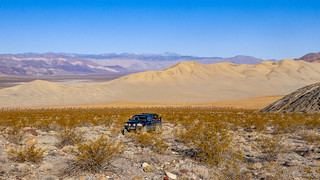
That exit - as anyone familiar with the area has likely already realized - was via Dedeckera Canyon and Steel Pass. This fun little section of road would be the most technical that we'd traverse in the park on this trip, and was something I'd been looking forward to since I'd traveled it in the opposite direction a little more than 18 months earlier. At the time, I'd had less experience, and was glad to have been descending the four closely-spaced obstacles through Dedeckera rather than climbing them; gravity seemingly in my favor.
This time, I was happy to climb them - the challenge of something a little more exciting, my motivating factor. It wasn't long before we hit the first narrow, rocky section.

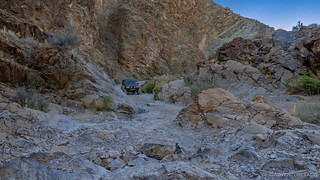

Well, I must say - while it was fun, and a little narrow... I've clearly been jaded by the last 18 months of adventures. This is - I suppose - to be expected, but at the same time I'd be lying if I didn't say I was a little bummed.
It was of course still a beautiful drive, and @mrs.turbodb - having been on fewer trips - got plenty of thrills as we squeezed through the various narrows and climbed up over the dry falls; the e-brake just strong enough to hold he truck without slipping in a couple of situations as I hopped out to snap a quick photo.


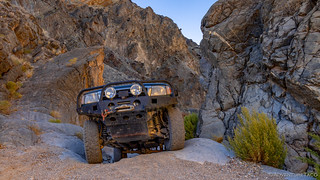
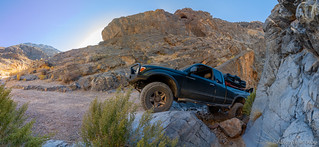
Something that was hard to capture on this trip through the canyon due to the long, early morning shadows - and that I think many people miss because they are focused on the driving - is that there are several very interesting looking side canyons branching off of the main wash. I had assumed that this might be my last trip through Dedeckera given its remoteness in relation to everything else in Death Valley National Park, but I can confidently say now that I will be back to this region - both to explore these side canyons, as well as several more places in Eureka Valley that have piqued my interest!
Today however, we passed by the side canyons and made our up and over through Steel Pass; we had places to be, and a limited number of hours to accomplish that be-ing.


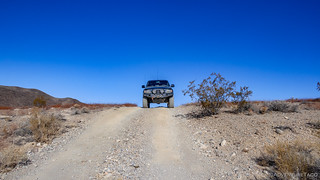
As Saline Valley opened up in front of us, we both took in our first view of where we'd be spending the next couple of days. This valley and the Inyo Mountains to its west were to be our stomping grounds - our goal to uncover, and yet still keep, a few of its secrets.
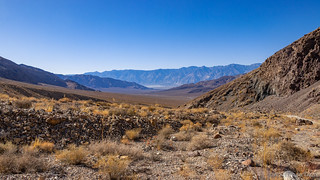
...So that's where this trip report is going to get a bit weird. I'm going to do things a little out of order and with some location redaction - in hopes of keeping a few of these special places special for just a little longer. If you find them, I think it'd be swell if you'd do the same!
While it's obvious that salt plays an important role in Saline Valley's history, I think most people who've been there are mostly - or only - familiar with the Salt Tram that carried the white crystals up and over the Inyo Mountains to the west, and out to the Owens Valley.

Well, it turns out that this was the both the initial and final path for the harvested salt, but it wasn't the only successful path over which the salt was transported. For that, we need to reach a bit deeper into the history of the operation. The brain child of an attorney named White Smith, the salt tram was constructed - at great cost - between 1911 and 1913.
Unfortunately, there were flaws in the construction which limited the amount of salt it could transport and by 1920, having transported only 5,000 tons of salt, Smith's company went bankrupt, and the tram was repossessed by the builder.
Not to be dissuaded, Smith lobbied the county to build a road from the Owens Valley to Saline Valley, via San Lucas Canyon. This road too took over two years to build. When completed, trucks would carry 10-ton loads of salt along a trail famed by miners to be "so precarious, it is only navigable by those crazy enough to do it drunk."
Last driven in the 1930's, no part of this dirt road is recognizable today - with one exception. At the most dangerous point on the route - where the road navigated around the edge of a 50-foot dry fall - a narrow ledge can be seen cut into the side of the canyon wall.
And that's where we were headed. Assuming my plan worked out.
See, rather than take the normal route from the top of San Lucas Canyon to the dry fall, I'd found a faint road and a side canyon that appeared to connect back into San Lucas - saving approximately 2 miles of hiking - assuming that it was passable. And it started with driving high above Saline Valley before parking the truck in a flexy spot at the top of the side canyon. 

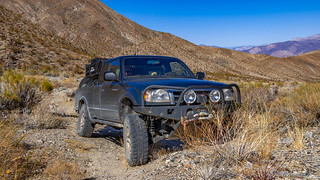

From there, we headed down the unnamed side canyon. Unlike Ken @DVExile, this was my favorite type of hike - where the down happens before the up. Way easier on the knees that way!

A mile or so in, our side canyon narrowed, and I looked over to @mrs.turbodb and declared, "Well, moment of truth. I hope there's no dry fall up ahead!"
Of course, there was a dry fall. Lucky for us, it was navigable. In fact, it was perhaps the most fun part of the hike - highly recommend!

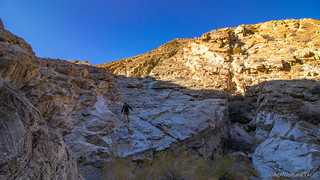
And with that, we joined up with the San Lucas Canyon as it snaked its way through the Inyo Mountains and toward Saline Valley.

Over the course of the next mile - and a 1,000-foot elevation drop - down San Lucas Canyon, the scenery was nothing short of spectacular. For anyone who is into geology, this is yet another place near Death Valley not to be missed.


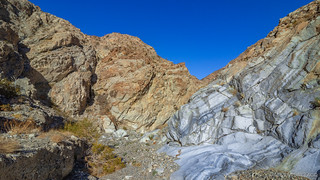
With brilliant oranges, striking blue, white, and black lines, and a nearly limitless array of twisted layers, our hike to our destination was peppered with gasps, finger pointing, and the sound of clicking cameras. Crickets chirped loudly in shady spots along the wash as we dizzily tried to take in everything around us.
And then, we reached the main attraction. Everything we'd seen so far paled in comparison. As the walls of the canyon narrowed to reveal the 50-foot dry fall, the colors, shadows, and canyon floor all came together to form what felt like a magical room in the middle of nowhere. We'd arrived.

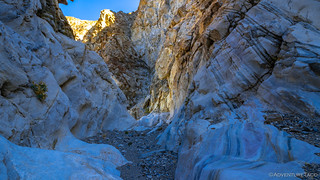
There, in front of us, was the old road bed carved into the canyon wall. That this was at one point driveable boggles the mind. To do it with a 10-ton load seems like it would have been foolish at best.
This is a hard place to capture, but we tried.

Looking "down" the old road, carved into the right canyon wall. The dry fall is straight ahead, over the edge.
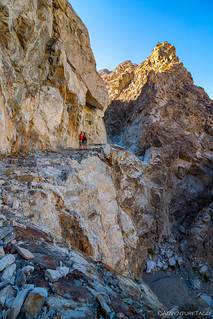
Looking "up" the old road.
With more time, we could have easily spent several hours poking around this amazing place. Old - surely hand built - retaining walls are now crumbling in the scree field they once supported. Large steel anchors - perhaps used to secure loads as they were transported along this dangerous section of trail - are now slowly rusting away. And an ammo box, with a few lonely signatures of visitors to this special place.
In fact, if not for the visitor immediately prior to us - who inspired this little adventure for me in the first place - we'd have been the first ones to sign the log since 2013, with only about a dozen entries since 1995!

Too soon, we knew it was time to turn back. It'd taken us 90 minutes to make the hike down the canyon, and we weren't sure how long the return trip would take, but we knew the sun set early and we had more that we wanted to do! So it was that as we looked up the entrance to the dry fall, the afternoon light beckoned us forward and we headed that direction.

We ended up making really good time - an hour or so, as I recall - back up both San Lucas and the side canyon via which we'd originally entered, the dry fall separating the two proving once again to be the most fun part of the hike! And with that, we were on our way.

Now - to get to-and-from the San Lucas Canyon hike, we had to traverse a couple of the more well-known features of the area: South Pass - at the south end of Saline Valley, and Lee Flat - south of Saline and west of Panamint Valley. Both @mrs.turbodb and I have done these before - this route being the same we'd taken after driving down Lippincot Pass a couple of years earlier - but that didn't mean we weren't any less captivated as we encountered them this time.
At South Pass, the Panamint Valley is revealed in all its glory as you come around the mountain, and then - as if the first sighting wasn't enough - there are several spectacular overlooks. This one in particular - with the dunes below - reminded me of the overlook we found of Eureka Valley the day before.

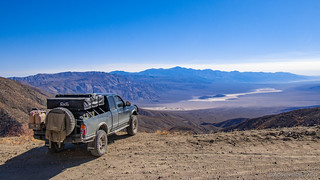
And who wouldn't be blown away in this Joshua Tree forest, strait out of a Dr. Seuss book? These trees - which can be up to 300 years old - grow only in very specific climates, and there's concern that within the next 50-100 years, many of the areas that contain high concentrations today will no longer be habitable due to climate change, resulting in between 80-99% of the trees dying off.

Having found the road used to transport salt from Saline Valley, we decided it would only be fitting to also hike a section of the more remote - western part - of the Salt Tram trail.
As I mentioned previously, this Salt Tram was built shortly after 1910, but underperformed before 1920 when the road through San Lucas Canyon was constructed. Smith, who'd always hoped to see the tramway come back to life died in 1927, but his company pressed on, reacquiring the property the next year. By December 1928, 60-100 tons of salt was being delivered each day to the Owens Valley, and some 30,000 tons were delivered by the time the tramway finally shut down.
We decided to hike the first 3.x miles of this trail - from Saline Valley to the first control tower - some ~1,700-feet up the sheer Inyo Mountains rising out of the valley floor. But first we drove to the end of the road, where we parked near an old tramway tower that had seen better days.
Note: After the trip, I discovered that we mistakenly drove the existing road to this tramway tower, as the road to it is not on the official Death Valley Map, and it is likely in the Inyo Mountain Wilderness. As such, I would recommend hiking from the Big Silver Mine Road, which is the nearest road on the Death Valley Map. Additionally, camping here is OK - as long as you hike up!

Our destination - high to the west - beckoned. The trail to achieve it, was unclear.

Luckily I'd created a track for this hike - so at 2:30 in the afternoon we set off on foot, hoping that we'd soon find a well-trodden trail. And, while we'd eventually find a trail, it was anything but well-trodden. Though, now I'm getting ahead of myself.
First, we discovered several old relics - tramway buckets, supporting brackets, and old cables littered the path between towers. Likely from both the time of operation as well as the decades since, this was quite obviously not an easy environment for steel.
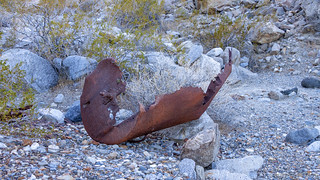
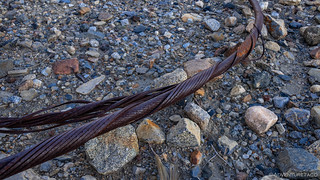

Eventually, we did find a trail - its width less than 18-inches wide as it switch-backed up the steep mountain. Passable, but barely.
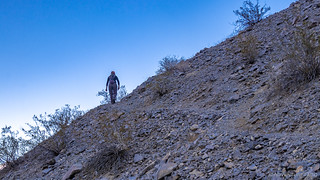
We pushed on, our elevation climbing quickly, our feet slipping here and there on the loose rock. As we went, the tram towers grew larger, the Tacoma in the distance, much smaller.


After an hour, we crested a hill that I'd say marked a little past the halfway point of the hike, and @mrs.turbodb had had enough. We'd already lost the trail a couple of times by this point - scrambling straight up to find the next switchback - and she decided that she'd wait here while I pushed on to the top...or at least to the top for us - the first control tower.
Which by the way was tantalizingly close when fully zoomed in. 

Setting out on my own, the next quarter mile was no problem at all. Moving quickly, I figured it'd be 45 minutes or so for me to cover the 2.5 miles to the tower and back. And then, things slowed down dramatically. As the angle of the mountain increased, the width of the trail decreased. No longer were the wide sections 18-inches and a little off-camber; they were now 6-inches, and fragile scree. In several locations, I found myself clinging to the loose rock above the trail, feet dislodging rocks on the edge, those rocks tumbling hundreds of feet down the nearly vertical face.
It was a dangerous situation, to say the least. And I hoped it would be over soon. But as I neared the next tower, I could see that my hopes were not going to pan out - because here, in a fold on the side of the mountain - the trail was gone. Literally washed away by the infrequent rain, a gap of maybe 7-feet between me and my next step, with a 50-foot drop in between.
Just across the gap, the trail continued - a dilapidated tram tower just waiting to be explored.

But, I had to turn around.
The Salt Tram trail is now - in my opinion - no longer navigable as a hiking trail. Time has taken its toll on the trail, and to do it now safely - at least from the east end - requires climbing equipment in this section at a minimum.
With mixed emotions - given that my adrenaline was pumping and yet I was also bummed - I headed back towards @mrs.turbodb who was waiting a few hundred feet below. As I relayed the story to her, she was glad she'd stayed behind, and urged us to get going back to the truck before it got too dark for us to see.
And that was fine by me.
We arrived back at the truck shortly after sunset, but still with plenty of light to see where we were going, and made the wise decision to set up camp here, rather than head back to the Saline Valley Warm Springs where I'd planned to have us spend the night.


Tired from a long day, a dinner of spicy tacos with guacamole hit the spot for both of us as - perched high above the floor - we looked out over Saline Valley and watched the chaos that was this popular place on a Friday night. Saline Valley Road, North Pass, and Steel Pass were repeatedly illuminated by the army of people making their way to the Warm Springs for the long weekend.
We were glad to be alone up here, away from it all, enjoying the best of what Death Valley has to offer.
Eventually we found ourselves ready for bed - the stars bright above us, and another great day in the books. Except that the day wasn't, quite, in the books. As we climbed up the ladder, I setup the camera for a series of long exposures - and it wouldn't be until later that we could really enjoy the end of this amazing day!
And to imagine - the biggest highlights of the trip were still yet to come!
The Whole Story
![Old Roads and Star Trails - In Search of Overlooks [2]](https://live.staticflickr.com/65535/49082756533_26e5373a5b_h.jpg)
![In Search of Overlooks - A Fall Trip to Western Death Valley [P1]](https://live.staticflickr.com/65535/49072602511_82aa16d541_h.jpg)























Wow....the dudes who drove that road had brass cajones...or as they say, were drunk!
Amazing what our forebears did to scrape a living out of the earth..
Thanks for sharing!
Fantastic! UJ